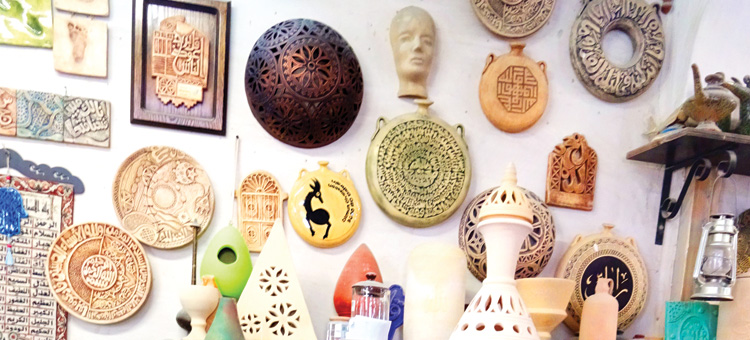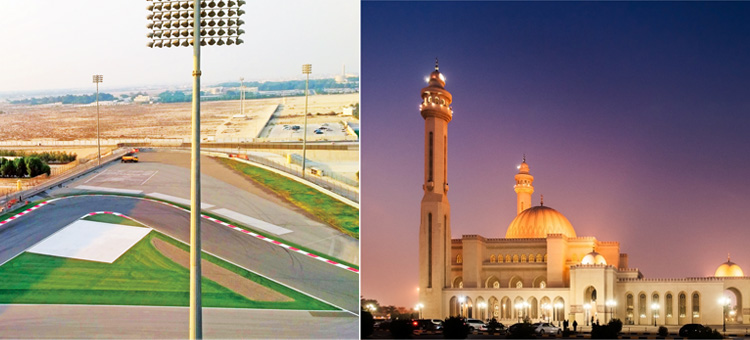Bahrain: When I was heading to Bahrain to explore its tourism destinations, the most common question I was confronted with was, “Why Bahrain? What is there to see?” As more people asked me the same, the thoughts lingered on my mind on the flight.
But what awaited me was a lot of impressive information about the history of a country that, unlike its glitzy neighbour Dubai, had not quite impressed upon travellers the richness of its tourist attractions. From the country with the first oil well to one that gives supreme importance to the education of girls and the empowerment of women (that took the cake for me); a place that is ready to go all out to preserve tradition while embracing the demands of modern life on one side; a place of religious harmony, there was much more to know.
I was lodged at Downtown Rotana, located near the busy shopping hub Manama Souq. After my four-day tour to some of the most important places in the country, I would say that the island destination is definitely worth knowing.
FOOD
One of the primary concerns that usually bother me during trips is food – call it the travails of being a vegetarian. Middle Eastern countries are mostly known for their non-vegetarian dishes so my apprehensions were slightly higher. But soon after my first stint with Bahraini food, those doubts flew out the window. This was at Saffron by Jena in Muharraq, the old capital of Bahrain. Breakfast itself is a luxurious affair for Bahrainis as they usually skip it altogether and have brunch instead. When they do get down to breakfast, which is only once or twice a week, it is an elaborate affair.
Our breakfast at Saffron by Jena, a traditional home converted into a hotel, was a lesson in tradition as well. To one side of the entrance was a pit, a madbasa, once used as a date press to procure molasses. Once an integral part of domestic life, parallel channels carved into the floor were seen where once dates would be piled. The weight of the dates pushing down and the room temperature would lead to the syrup being extracted into earthen jars.
Coming back to the food, it was a combination of fried chickpeas, red beans, Zinjibari and mini bread rolls stuffed with cheese. This was apart from tomatoes and eggs, and a side of mashed brown beans. The non-vegetarians in our group were served mihyawa – a roti-like bread from Iran where bread is folded and sprinkled with fish sauce. Youngsters, it seems, also prefer to have savoury samosas.
On another occasion, I also visited the Hajis Café in Manama Souq, that was opened in 1950. A family-run hotel, their menu was a non-vegetarian’s paradise with a choice of chicken and beef liver, plain beef and chicken served for breakfast. For foodies, there’s Adliya 338, where street food can be explored at leisure. There are pleasantly surprising contemporary artwork installations on every street corner and playgrounds for children abound.
On the very first day, I had the opportunity to take a culture tour around Shaikh Isa Bin Ali House, Shaikh Ebrahim Cultural Centre and houses in Old Muharraq. Once the house of Shaikh Isa Bin Ali Al Khalifa, the seventh ruler of Bahrain, its resemblance to traditional homes in India is striking. The roof or ceiling which is made of woven palm fronds is called ‘chandal’. Chandal was a sign of affluence as the fronds had to be imported from India and China.
The house has separate wells – one each for the family, guests and househelps. Guests are hosted near the kitchen so that they can help themselves whenever hunger comes calling. There are separate rooms, called majlis, for men and women.
Next we headed to Shaikh Ebrahim bin Mohammed Al Khalifa Center for Culture and Research. Since its opening in 2002, more than 400 artists, speakers, philosophers and poets have visited the centre for open exchange of ideas and knowledge.
I also got to see old Muharraq houses of pearl divers. Some had been renovated, but there were old ones too, with inhabitants. Nearby was the ‘newspaper house’, where Abdulla Al Zayed, the person who first brought out a newspaper in the Arabian Gulf in 1935, lived. A part of the UNESCO® World Heritage Site since 2013, this 100-year old house preserves Bahrain’s press heritage and hosts lectures. There is also a Kurar House, a small traditional production centre for unique local embroidery and handicrafts. Lunch was at the House of Coffee, a traditional house turned coffee-themed space with crystallised sugar sticks suspended from the ceiling.
The culture vulture in me was delighted to be taken to Al Jasra Handicrafts Centre in Jasra Village. This was established by the Ministry of Industry and Commerce in 1990 to revive the dying crafts including ship-building, pottery, weaving, and gypsum architecture works.
A VROOMING EXPERIENCE
Your adrenaline is definitely going to race as you enter Bahrain International Circuit (BIC), the destination for motor sport aficionados. It is Michael Schumacher who won the Bahrain Grand Prix, the first Formula One race in the Middle East that comes to mind here. The circuit, designed by German architect Hermann Tilke, was opened to the public on April 2004. It is the brainchild of Crown Prince Shaikh Salman bin Hamad Al Khalifa, an ardent sports lover.
Among all the stands in the BIC, the biggest, most expensive one is the Grand Stand with a seating capacity of 10,500 people. The spectators can see the main track, start and finish line from here. There is also the VIP tower which is off-limits to the public and cannot be booked in advance as it is exclusively for VIPs and their entourage. The first turn in the racing track, prone to accidents as the race starts at a speed of 350 km/hr is also called Schumacher’s Turn as it was his idea to add the feature there to entertain his audience. You can view the Mountain of Smoke – the highest natural point in Bahrain, upto 135 metres high from the VIP gallery, with oil wells around it.
The icing on the cake, however, was the trip through BIC in a Land Rover – my first such experience in a four-wheel drive. The person behind the wheel, Mahmood Aden was kind enough to make us feel at ease during the 3.5 km drive on the track. We had more than ten obstacles to cover, some natural, others manmade. The drive lasted a little more than 30 minutes, with boulders, rough roads and narrow water channels to manoeuvre. The track was sponsored by Land Rover in 2005.
SHAJARAT AL HAYAT (TREE OF LIFE)
After the fun ride, we headed to the ‘mortal’ Tree of Life in Bahrain, said to be more than 400 years old. In the Sakhir rocky desert, it is held in great esteem by Asians who worship it. Touching the tree is believed to make one immortal. On this day, there were some Thais lighting incense and offering prayers. The leaves of the trees are rarely shed and are instead, a verdant hue. There is a small Visitors’ Centre that was opened in April 2014 where open air performances are conducted in the 500-seater amphitheatre. We had arrived by evening, and I was just as glad, for the dusk added to a mysterious ambience, the tree bathed in the rays of the setting sun.
KING FAHD CAUSEWAY
The second day began by visiting one of the world’s longest bridges – King Fahd Causeway, Centre for Culture and Research and meeting the officials of Bahrain Tourism and Exhibition Authority (BTEA). The 25-km causeway was opened in 1985. The stretch that connects Saudi Arabia and Bahrain has been named after King Fahd bin Abdul Aziz. He was one of the 45 sons of Saudi founder Ibn Saud. One half of the causeway is owned by Bahrain and the other half by Saudi Arabia. This is the only connection to Saudi Arabia, enabling people from Oman and Qatar also to enter Saudi Arabia.
AT HOME, IN BAHRAIN
Bahrain has a 200-year old Sree Krishna temple in Manama – the first Hindu temple in the Arabian Gulf region and Bahrainis also celebrate Diwali with the Indian community. Bahrain is a country that respects other religions as well. The Al Fateh Grand Mosque, with the world’s largest fibre glass dome, accommodates 7000 worshippers and also welcomes non-Muslim visitors outside of prayer times.
A WEDDING DESTINATION
Since April 2016, Bahrain has been promoted as a wedding destination. The country hosted an Indian wedding in April 2017, which saw around 15,000 to 16,000 guests.
Bahrain invites potential wedding parties and assists them in fast tracking their visa processing, transportation and meeting with wedding planners. Khaled Bin Humood Al Khalifa, the CEO of BTEA, personally meets a wedding party. The country has hosted four weddings so far and there are bookings lined up. The wedding season in Bahrain is from November to April.
“The kindness of Bahrainis is the USP of our country,” said Dr. Ali Hassan Follad, Advisor, BTEA. “In terms of safety and security, we are the number one country for expats,” he added. “We hope to also draw wedding parties and leisure tourists from Europe.”
“Saada West, a new seafront property, will be developed in the Muharraq area by 2019 to promote water sport activities such as diving,” said Dr. Ali. He also spoke about the new convention centre coming up in Bahrain by 2020 or 2021 that will offer a fillip to MICE tourism.
CAMEL FARM, JANABIYA
It would be a shame to visit a country in the Middle East and not have a close encounter with its ‘national’ animal, the camel. Housing about 450 camels, royal ones, mind you, the farm belongs to the late Sheikh Mohammed Bin Salman Al Khalifa. Call it an orphanage for camels. They were once owned by royal families. Fed on wheat, they are not raised for meat or any other purpose for that matter. They are milked in the morning and it can be collected free of cost between 5 and 6 am. The camels, weighing 480 kg each, also have yearly beauty pageants where the one with the best fur gets the crown (FYI, I got a selfie clicked with one of the beauties). The camels are taken by royal families to the pageant that is mostly held in the Emirates and Saudi Arabia. The fur, however, is shaved off to help them cope in the sweltering heat.
A’ALI POTTERY VILLAGE
For someone who likes pottery and drools over terracotta products, the A’ali Pottery Village was where I stood mesmerised. In this village, pottery was a means of livelihood to more than 70 per cent people but due to a lack of financial support, only six factories now remain. The profession is passed down from father to son, the pots resembling those found in ancient Dilmum, an archaeological site. The potters still fire their pieces using ancient kilns and traditional methods. The factories once also made potteries used for burial purposes.
JARADA ISLAND
My Bahrain adventure was wrapped up with a visit to Jarada Island. A 40-minute ride through the waters, Jarada is a small island that disappears during high tide.







